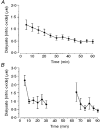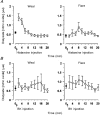Role of nitric oxide in the regulation of microvascular perfusion in human skin in vivo
- PMID: 10087352
- PMCID: PMC2269258
- DOI: 10.1111/j.1469-7793.1999.0549v.x
Role of nitric oxide in the regulation of microvascular perfusion in human skin in vivo
Abstract
1. Nitric oxide (NO) concentrations were measured in dialysate from healthy human skin, in vivo, both at rest and during the inflammatory response to intradermal histamine or bradykinin. Changes in dialysate NO concentration, measured by electrochemical detection, were related to changes in dermal vascular perfusion, measured using scanning laser Doppler imaging. 2. Basal NO concentration in dermal microdialysate was 0.60 +/- 0.14 microM (mean +/- s.e.m.). Following the intradermal injection of histamine, a transient, time-dependent increase in NO concentration was measured in areas of skin incorporating the weal and in others incorporating the flare. The increase in NO concentration was associated with an increase in dialysate cGMP concentration in both the weal and flare areas. 3. Addition of N G-nitro-l-arginine-methyl ester (L-NAME, 5 mM) to the probe perfusate resulted in an inhibition of the histamine-induced increase in NO and cGMP. Moreover, the reduction in dialysate NO concentration was associated with a reduction in dermal vascular flux, both under basal conditions and within the weal and flare response. 4. These results demonstrate, by the use of microdialysis, that vasoactive mediators can be measured in healthy human skin in vivo. They provide direct evidence that endogenous concentration of NO increases during the inflammatory weal and flare response to histamine and that the increase in dermal NO concentration is associated with increases in cGMP concentration and dermal vascular perfusion, thus confirming a role for NO in vasoregulation in human skin.
Figures




 ). Dialysate was collected from both the weal and flare areas of the histamine response. Maximum values in the weal occurred 2-4 min (P < 0·001) after provocation with histamine and that in the flare 6-8 min (P < 0·01). All columns represent the means +
). Dialysate was collected from both the weal and flare areas of the histamine response. Maximum values in the weal occurred 2-4 min (P < 0·001) after provocation with histamine and that in the flare 6-8 min (P < 0·01). All columns represent the means +


Similar articles
-
Effects of H1 antagonists on the cutaneous vascular response to histamine and bradykinin: a study using scanning laser Doppler imaging.Br J Dermatol. 1998 May;138(5):806-14. doi: 10.1046/j.1365-2133.1998.02217.x. Br J Dermatol. 1998. PMID: 9666826 Clinical Trial.
-
Measurement of nitric oxide concentration in human skin in vivo using dermal microdialysis.Exp Physiol. 1998 May;83(3):431-4. doi: 10.1113/expphysiol.1998.sp004126. Exp Physiol. 1998. PMID: 9639352
-
The neurogenic vasodilator response to endothelin-1: a study in human skin in vivo.Exp Physiol. 2000 Nov;85(6):839-46. Exp Physiol. 2000. PMID: 11187978
-
Experimental models of skin inflammation.Clin Exp Allergy. 1999 Jul;29 Suppl 3:105-8. doi: 10.1046/j.1365-2222.1999.0290s3105.x. Clin Exp Allergy. 1999. PMID: 10444222 Review.
-
Vascular responses in the skin: an accessible model of inflammation.News Physiol Sci. 2002 Aug;17:170-4. doi: 10.1152/nips.01378.2001. News Physiol Sci. 2002. PMID: 12136047 Review.
Cited by
-
Measurement of nitric oxide release evoked by systemic hypoxia and adenosine from rat skeletal muscle in vivo.J Physiol. 2005 Nov 1;568(Pt 3):967-78. doi: 10.1113/jphysiol.2005.094854. Epub 2005 Aug 25. J Physiol. 2005. PMID: 16123106 Free PMC article.
-
H1 but not H2 histamine receptor activation contributes to the rise in skin blood flow during whole body heating in humans.J Physiol. 2004 Nov 1;560(Pt 3):941-8. doi: 10.1113/jphysiol.2004.071779. Epub 2004 Sep 16. J Physiol. 2004. PMID: 15375193 Free PMC article.
-
Magnesium lithospermate B ameliorates microcirculation perfusion in rats by promoting vascular NO production via activating the PI3K/AKT pathway.Acta Pharmacol Sin. 2019 Aug;40(8):1010-1018. doi: 10.1038/s41401-018-0203-7. Epub 2019 Feb 13. Acta Pharmacol Sin. 2019. PMID: 30760835 Free PMC article.
-
Responses of nitric oxide-cGMP release in acupuncture point to electroacupuncture in human skin in vivo using dermal microdialysis.Microcirculation. 2009 Jul;16(5):434-43. doi: 10.1080/10739680902915012. Epub 2009 May 26. Microcirculation. 2009. PMID: 19468961 Free PMC article.
-
ACh-induced endothelial NO synthase translocation, NO release and vasodilatation in the hamster microcirculation in vivo.J Physiol. 2002 Nov 1;544(3):883-96. doi: 10.1113/jphysiol.2002.021972. J Physiol. 2002. PMID: 12411531 Free PMC article.
References
-
- Anderson C, Andersson T, Wårdell K. Changes in skin circulation after insertion of a microdialysis probe visualized by laser Doppler perfusion imaging. Journal of Investigative Dermatology. 1994;102:807–811. 10.1111/1523-1747.ep12378630. - DOI - PubMed
-
- Andoh T, Kuraishi Y. Quantitative determination of endogenous nitric oxide in the mouse skin in vivo by microdialysis. European Journal of Pharmacology. 1997;332:279–282. 10.1016/S0014-2999(97)01114-X. - DOI - PubMed
-
- Benrath J, Eschenfelder C, Zimmerman M, Gillardon F. Calcitonin gene-related peptide, substance P and nitric oxide are involved in cutaneous inflammation following ultraviolet irradiation. European Journal of Pharmacology. 1995;293:87–96. - PubMed
-
- Bito L, Dawson H, Levin E, Murray M, Snider N. The concentrations of free amino acids and other electrolytes in cerebral spinal fluid, in vivo dialysate of brain, and blood plasma of the dog. Journal of Neurological Chemistry. 1966;13:1057–1067. - PubMed
-
- Bruch-Gerharz D, Ruzicka T, Kolb-Bachofen V. Nitric oxide in human skin: current status and future prospects. Journal of Investigative Dermatology. 1998;110:1–7. - PubMed
Publication types
MeSH terms
Substances
Grants and funding
LinkOut - more resources
Full Text Sources

